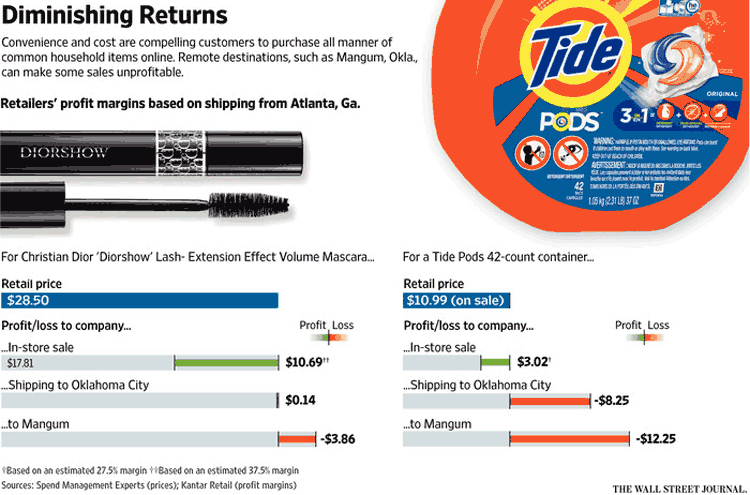The good news for many etailers is that more and more consumers living in relatively remote and rural areas are increasing their purchases on-line. But for many of them, that's also the bad news, as fulfillment cots can quickly lead to losses not profits, as the face of retail continues to evolve.
In the first wave of changes in rural and smaller town America, the entry of Walmart and other big box stores wreaked havoc on local merchants and smaller chain stores serving those communities. But now, on-line shopping may be taking a piece of the Walmart and other big chains' business too - or at least changing the cost dynamics.
Supply Chain Digest Says... |
 |
Consider those picking and then subsidized shipping costs if a consumer is order say food, paper goods or similar products that cost just a few dollars each, and provide generally thin margins.

|
What do you say? |
| Click here to send us your comments |
 |
| Click here to see reader feedback |
|
|
According to Kantar Retail, about 73% of rural consumers, which it defines as those who drive at least 10 miles for everyday shopping, are now buying on-line versus 68% two years ago. Last year, 30% were members of Amazon Prime, up from 22% in 2014.
Consider the town of Magnum, OK, population 3000. After a Walmart in the area killed off local retailers 20 years ago, residents there still had to drive 30 minutes to get to the store, and two and a half hours to reach Oklahoma City with more choices. Many have now decided ordering on-line is much easier - especially if etailers entice them with low shipping and zero handling costs.
On-line shopping and fulfillment, it seems, has become the new Wells Fargo Wagon for small town America.
In a recent article on the topic, the Wall Street Journal told the story of UPS driver Vince Bledsoe, who serves the Magnum market. Until a few years ago, he mostly delivered oddball items, spare parts and other business to business orders to the town.
Now, the Journal says, “He delivers dog food, fruit snacks and Kleenex, among other things. His business has increased 30% during the past couple of years.”
On-line options have enabled shoppers in smaller and even mid-sized towns access to not only staple goods but of course a range of new and fashion merchandise they didn't have locally before from Walmart or Dollar General.
So, whether its Walmart itself, Amazon and/or other retailers, someone is building a new sales channel in towns like Magnum and hundreds or thousands of other such locations. But the financial results may not be so attractive.
It can costs a lot to ship ecommerce orders to small towns, much more than shipping large quantities to retail stores, and many retailers of course subsidize those costs with discounted or even free shipping.
But of course the shipping isn't really free - there are regular parcel shipping charges, plus a list surcharge price from both UPS and FedEx of $4.00 for remote rural deliveries -which retailers may or may not try to pass on.
Retailers are also constrained by policies that promote consistency across channels in terms of prices. If anything, there might be a web note that on-line prices could be lower than store prices.
(See More Below)
|
CATEGORY SPONSOR: SOFTEON |
|
|
| |
|
|
So, even without considering shipping charges, it costs significantly more to pick and pack a single unit for an on-line order than it does to get that unit (from a case delivered to the store) on the shelf for a consumer to pick him or herself. But virtually no retailers anymore try to add a "handling" or picking charge to the on-line price.
Consider those picking costs plus subsidized or free shipping costs if a consumer is ordering perhaps food, paper goods or similar products that cost just a few dollars each, and provide generally thin margins.
The Wall Street Journal article, for example, focused on a make-up product from Christian Dior and some Tide laundry
detergent from Procter & Gamble, and delivery to the somewhat remote
Oklahoma City and an even more remote city of Magnum, based on
shipping from a DC in Atlanta, GA.
The financial impact for a retailers on the full transactions is illustrated in the graphic below.
On-Line Fulfillment and Shipping Costs Can Wreak Havoc on a Retailer's Bottom Line

Not a pretty picture, as presented, with basically no profit or heavy losses for the on-line sales.
Now, there are all kinds of questions and issues here. Many/most/all retailers would ship from far closer sourcing points to Oklahoma than from Atlanta. Walmart could ship from its local store 20 miles away, for example, and likely it has a DC not too far away as well - though its store and DC density are of course unrivalled among retailers (except for Amazon on the DC side).
It's also not clear if order picking costs are included in the analysis, and how those are calculated, an how the analysis handles shipping costs incurred by a retailer and paid (if at all) by a customer.
So, SCDigest believes these numbers are exaggerated - but are likely directionally correct. The WSJ article notes many consumers in more remote an rural areas are often cutting back store visits, putting a double whammy on retailers: fewer more profitable store sales plus more money-losing on-line volumes.
At some point, something will have to give in eFulfillment- the question is when.
What's your reaction to these fulfillment scenarios? Will retailers ever actually charge what it actually costs? Let us know your thoughts at the Feedback section below.
Your Comments/Feedback
|